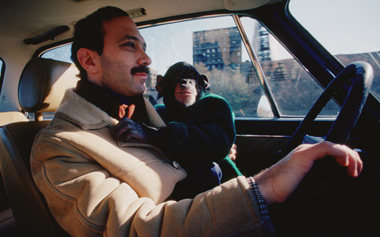In its short but storied history, cinema has had its share of missteps. Rock Hudson played a Native American in the 1950 Jimmy Stewart vehicle Winchester ’73. Fred Astaire and Buster Keaton both wore blackface. Michael Bay is still making movies about talking cars.
The heyday of the chimp movie has probably, and thankfully, come and gone. There was a time when a quick comedy hit seemed almost more likely than not to feature, at some point between scenes of break-dancing and computer hacking, a cigar-chomping chimp in a diaper or snappy red jacket and cap, doing his best George Burns impression.
The trend reached its apotheosis with a pair of Clint Eastwood films—Every Which Way but Loose and Any Which Way You Can—that co-starred a pair of orangutans (they played the same character—Clyde—but the ape from the first film had grown too large and too strong to play in the sequel). Not long after, the company that trained them was accused of beating the animals with axe handles. Sadly, one suspects it was not an uncommon practice.
I was reminded of our fascination with these close relatives (and our mistreatment of them) by the arrival this week of Project Nim, a new film from James Marsh (Man On Wire) that charts the life of a chimpanzee born just a few years before Eastwood and Clyde hit the big screen. Born at a research center in Oklahoma during the fall of 1973, the chimp was christened Nim, then promptly stolen from his mother and delivered to a new family. A human family.
Nim would be at the center of a radical experiment run by Columbia University professor Herbert Terrace. The basic idea was that a chimp, if raised by humans as one of their own, could learn to communicate in our own sign language. The hope was that as time went by, Nim—like any child—would slowly acquire the words and grammar necessary to tell us his own story, forever breaking down the wall between man and ape.
It was not to be. Nim—his full name, Nim Chimpsky, was a very thinly veiled dig at the competing theories of linguist Noam Chomsky—lived the life of an orphan, caroming from Oklahoma to a Manhattan townhouse to an estate in the Bronx. His adoptive families could never keep up with him: his outbursts, his biting, his essential chimp-ness. His language development never advanced as well as Terrace had hoped; Nim was sent into retirement and eventually sold to a medical testing facility.
If it seemed a sad end, it would get sadder. Rescued from his life as a medical subject by a well-intentioned animal rights activist, Nim is bundled off to an animal reserve—where it’s discovered that the chimp cannot communicate with his non-signing brethren. Yet for all the heartache on display, much of it was born of love—Marsh interviews many who considered Nim a strange kind of family member, and at least one psychology student admits to sharing a joint with the ape. In the end, Nim’s story says much more about the permissive and self-absorbed attitudes of the 1970s, and the many people whose lives he touched, than it ever could about one chimp.
*
Also this week: Amherst Cinema continues its Humphrey Bogart summer movie series with two screenings of the 1948 John Huston gold-fever chronicle The Treasure of The Sierra Madre. Bogie stars as Fred C. Dobbs, a prospector and paranoid bully who becomes convinced that his partners are out to kill him and take his gold. Huston’s tight grasp on the unraveling of Dobbs’ mind is a study in directing skill, but the film is perhaps best remembered for a single line—one usually misquoted. For the record, the line is: “Badges? We ain’t got no badges. We don’t need no badges! I don’t have to show you any stinkin’ badges!”
Use it well.
The Treasure of The Sierra Madre screens at Amherst Cinema Sunday, Aug. 7 at 2 p.m. and Wednesday, Aug. 10 at 7:30 and 10 p.m.
Jack Brown can be reached at cinemadope@gmail.com.



